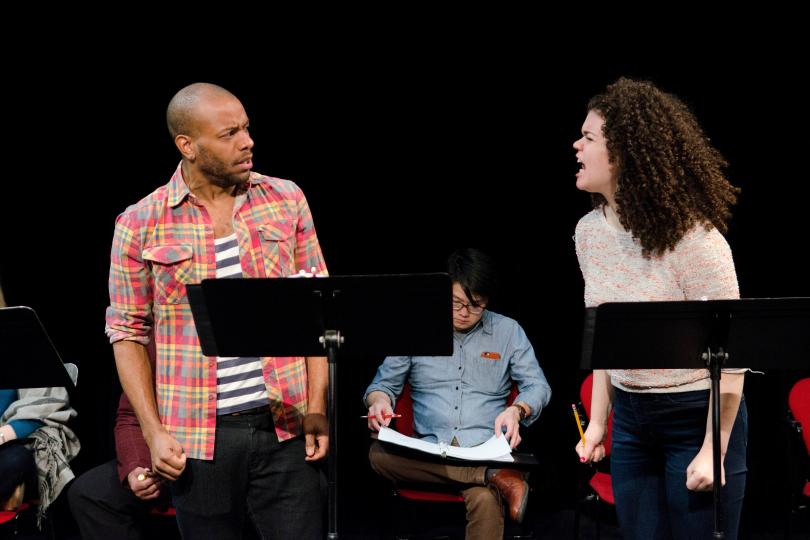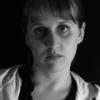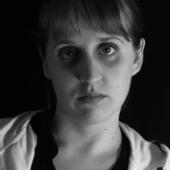Connection Beneath The Sea & The Stars

I was brushing my teeth the other night and Natalie Imbruglia’s “Torn” popped into my head.
There’s nothing where he used to lie/Conversation has run dry
Actually, it wasn’t Natalie Imbruglia exactly, but Jon-Michael Reese scream-crying “Torn” at an imaginary karaoke bar in Florida. See, I had just been to the Playwrights’ Center for their reading of Core Writer Harrison David Rivers’ play The Sea & The Stars and bits of it were following me around, like a mysterious talking parrot at your family’s beach house.
The setting of Rivers’ play is Jupiter, which I initially took to be the planet but is actually a small town in Palm Beach County, peopled with lonely eccentrics and the aforementioned talking parrot. Two men juggling broken hearts and family obligations collide on the beach in this joyful, bittersweet piece.
I had finally caught Moonlight the day before, so this play fit neatly into the “Stories of Men Connecting Romantically in Florida Near the Ocean Written by Exemplary Young Black Playwrights With Three Names” Festival I had concocted for myself.
Rivers is based in St. Paul, having been lured from New York to the Twin Cities by a Jerome Many Voices Fellowship a few years ago. Luckily for us, he stuck around. He picked up a McKnight Fellowship last year and is in the midst of his term as a Core Writer at the Playwrights’ Center.
The Sea & The Stars is part of the Ruth Easton New Play Series, the public reading series for the Center’s Core Writers. The 2016-2017 season includes Mat Smart’s Eden Prairie, 1971 and Lee Blessing’s upcoming Minneapolis/St. Paul, so either Minnesota is looming large in the collective playwright imagination, or Core Writers know their audience.
Selected playwrights are given several days to work with their cast, director, and a dramaturg, culminating in two public readings. Many scripts change dramatically over the course of rehearsal. Rivers is notoriously industrious, even rewriting scenes between the Monday and Tuesday night readings. As an audience member, I was thrilled to hear that some of my favorite moments were written that day. Take that, Monday night audience!
The Tuesday night audience was packed and seemed to be play reading veterans. Nobody batted an eye at the row of music stands and chairs that encompassed the entire set. I overheard many people comparing and contrasting previous readings they had seen. The couple next to me scanned the program carefully, combing through the bios for where they had heard that name before. “Ooh! Austene Van! She’s good,” they said.
Readings are a bit like radio plays. There’s no set, no costumes, no props. The audience has to conjure the starlight on the beach, the costuming of a human-sized parrot, and an unwanted beta fish. Because there’s so little one can do, what is done stands out. There’s extra delight in clever music stand blocking or when actors incorporate their binders into their performance.
The Center brings in a designer for their Ruth Easton plays to help bridge the gap between performance and reading, in this case sound designer Adam Wernick. Sound brought a lot to the piece, whether it was the voicemails or the power ballads or even the crashing waves filling and deepening the contemplative silences.
As an audience, we brought a lot of sound to the piece as well. I think reading audiences are more vocal. We hooted and hollered at the karaoke performances. Wise words from Mister Harold Umstead, played by a grounded Terry Bellamy, elicited an audible “Hmm” of pleased recognition from the crowd. I don’t know that we would have “hmm”-ed as loudly for a fully staged play. We wouldn’t need to fill the space in the same way.
As an audience, we have a job to do at a reading. As Artistic Director Jeremy Cohen pointed out in his pre-show speech, this is not a performance, but an open rehearsal. Everyone’s here to work. The goal of the evening is not to present a polished piece for the audience to enjoy, but to help the playwright hear how the play lives in a room. Our job is to listen and be present.
A play is more than words. It’s more than actors saying words. It’s actors saying words in front of people. What works on the page or in a rehearsal room may change completely in front of an audience. Hearing a play out loud in front of an audience can be invaluable, but our reaction isn’t really the point. As Rivers indicates in an interview with the Playwrights’ Center, “A playwright can’t base their impressions of their work entirely on the reaction of the audience. It’s just not healthy.” We’re more of a barometer, allowing the writer to read the tension and pacing, to hear what lands and what sinks.
There are lots of things that stick with me from this story: a drunken man in floaties, a parrot erasing a voicemail, the untrustworthiness of a man with a last name for a first name, being lectured on determining the ripeness of mangoes. But worming into my ear are those darn karaoke songs. There was a point in the piece where a character’s performance becomes contagious and her Wilson Phillips song breaks out and takes over the play. For a moment, the theater was absolutely, fully transformed from a couple of music stands on a stage, to a dingy bar in Florida, to a band of lonely people yearning for connection and reaching out to touch one another with only the power of a power ballad.
Someday somebody’s gonna make them want to turn around and produce this play. And I’ll hold on for that.




